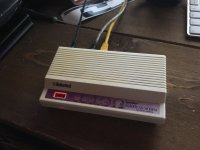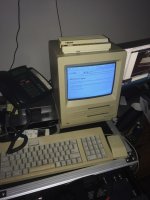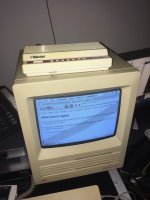TechEdison
Well-known member
A topic (that is currently pinned) exists with a tutorial for connecting your Macintosh to the internet using USB -> serial, but it is very outdated and I ran into several issues while following it. I'm going to add further instruction to it (which is mostly copied from a reply to a thread I made).
For starters, some amazon links!
USB->Serial: https://www.amazon.com/gp/product/B00J4N9T9C/
RS422->RS232: https://www.amazon.com/gp/product/B000068OEQ/
Original page (you'll need this for most of the tutorial):
There were a few things I had to do differently.
First, you cannot do it on a modern system for some reason. The PPP daemon for Linux just doesn't do what you would need, and the one for a later OS X (in my case 10.7) would not run. I ended up using my iBook G4, but had to get ancient PowerPC drivers for the USB->Serial adapter from https://web.archive.org/web/20071114081401/http://www.prolific.com.tw:80/eng/downloads.asp?ID=31. In the end I got a nice tty.usbmodem to work with.
Nowhere on any pages of this thread does it tell how to properly setup MacTCP, which I had to experiment with for quite a while. Here are the steps I did:
[*]Click "OK"
[*]You should have a box for "IP Address" when you click ok. Set that to something similar to one on your network (for example, gateway is 192.168.0.1, ip is 192.168.0.123)
[*]Click the close button and restart
* I have not yet been able to resolve any domain name outside the router, which I have yet to figure out. I will include instructions and code for a simple proxy.
Once MacTCP is setup, make a MacPPP profile with no phone number and baudrate set at 57600. Assuming you've already got drivers figured out for your system, connect the vintage mac to your internet-connected mac and open a terminal to type the commands in the above thread. Make sure the baudrate is the same as you set in MacPPP. Hit "Open" on MacPPP and -whoosh- you're connected to the internet!
If anyone has ideas on how to fix name resolution, please reach out to me! Currently its very tricky to get anything done using my script.
Proxy Instructions:
Make sure you have a simple web server (with PHP installed) running on some other computer of your home network that CAN access the outside world. In your WWW directory (I won't be explaining setup since there are plenty of tutorials) create a file called proxy.php and put this inside:
<?php
$ip = "192.168.0.110";
//Get the raw html.
$furl=trim($_GET["url"]);
$raw = file_get_contents($furl);
//proxy everything
$replacethis="href='";
$replacestring="href='http://$ip/proxy.php?url=";
$raw=str_replace($replacethis,$replacestring,$raw);
$replacethis="href=\"";
$replacestring="href=\"http://$ip/proxy.php?url=";
$raw=str_replace($replacethis,$replacestring,$raw);
$replacethis="<head>";
$replacestring="<head><base href='http://$ip/proxy.php?url=".$_GET['url']."'>";
$raw=str_replace($replacethis,$replacestring,$raw);
//Echo the website html
echo $raw;
?>
Change $ip to the IP of your computer (you can find this with ifconfig in linux and mac, or ipconfig in windows), and connect to a website on your mac using: http://<YOUR IP>/proxy.php?url=<URL YOU WANT TO VISIT>
This will not only fix the DNS problem, but also allows you to access HTTPS sites which are not supported on your mac.
For starters, some amazon links!
USB->Serial: https://www.amazon.com/gp/product/B00J4N9T9C/
RS422->RS232: https://www.amazon.com/gp/product/B000068OEQ/
Original page (you'll need this for most of the tutorial):
There were a few things I had to do differently.
First, you cannot do it on a modern system for some reason. The PPP daemon for Linux just doesn't do what you would need, and the one for a later OS X (in my case 10.7) would not run. I ended up using my iBook G4, but had to get ancient PowerPC drivers for the USB->Serial adapter from https://web.archive.org/web/20071114081401/http://www.prolific.com.tw:80/eng/downloads.asp?ID=31. In the end I got a nice tty.usbmodem to work with.
Nowhere on any pages of this thread does it tell how to properly setup MacTCP, which I had to experiment with for quite a while. Here are the steps I did:
- Set "Obtain Address" to manual
- Set gateway address as your router's IP address (in my case, 192.168.0.1)
- Set "Class" (in the IP Address settings) to C
- Make sure your subnet is correct (in my case, 255.255.255.0)
- Set your domain name servers to: *
URL: ignore.com (literally just this) IP: 8.8.8.8
- URL: ignore.com IP: 8.8.4.4
[*]Click "OK"
[*]You should have a box for "IP Address" when you click ok. Set that to something similar to one on your network (for example, gateway is 192.168.0.1, ip is 192.168.0.123)
[*]Click the close button and restart
* I have not yet been able to resolve any domain name outside the router, which I have yet to figure out. I will include instructions and code for a simple proxy.
Once MacTCP is setup, make a MacPPP profile with no phone number and baudrate set at 57600. Assuming you've already got drivers figured out for your system, connect the vintage mac to your internet-connected mac and open a terminal to type the commands in the above thread. Make sure the baudrate is the same as you set in MacPPP. Hit "Open" on MacPPP and -whoosh- you're connected to the internet!
If anyone has ideas on how to fix name resolution, please reach out to me! Currently its very tricky to get anything done using my script.
Proxy Instructions:
Make sure you have a simple web server (with PHP installed) running on some other computer of your home network that CAN access the outside world. In your WWW directory (I won't be explaining setup since there are plenty of tutorials) create a file called proxy.php and put this inside:
<?php
$ip = "192.168.0.110";
//Get the raw html.
$furl=trim($_GET["url"]);
$raw = file_get_contents($furl);
//proxy everything
$replacethis="href='";
$replacestring="href='http://$ip/proxy.php?url=";
$raw=str_replace($replacethis,$replacestring,$raw);
$replacethis="href=\"";
$replacestring="href=\"http://$ip/proxy.php?url=";
$raw=str_replace($replacethis,$replacestring,$raw);
$replacethis="<head>";
$replacestring="<head><base href='http://$ip/proxy.php?url=".$_GET['url']."'>";
$raw=str_replace($replacethis,$replacestring,$raw);
//Echo the website html
echo $raw;
?>
Change $ip to the IP of your computer (you can find this with ifconfig in linux and mac, or ipconfig in windows), and connect to a website on your mac using: http://<YOUR IP>/proxy.php?url=<URL YOU WANT TO VISIT>
This will not only fix the DNS problem, but also allows you to access HTTPS sites which are not supported on your mac.
Last edited by a moderator:








